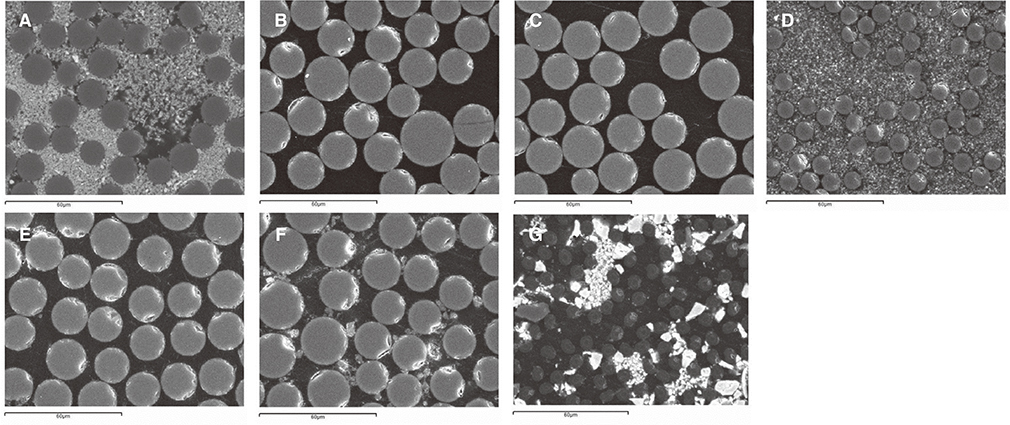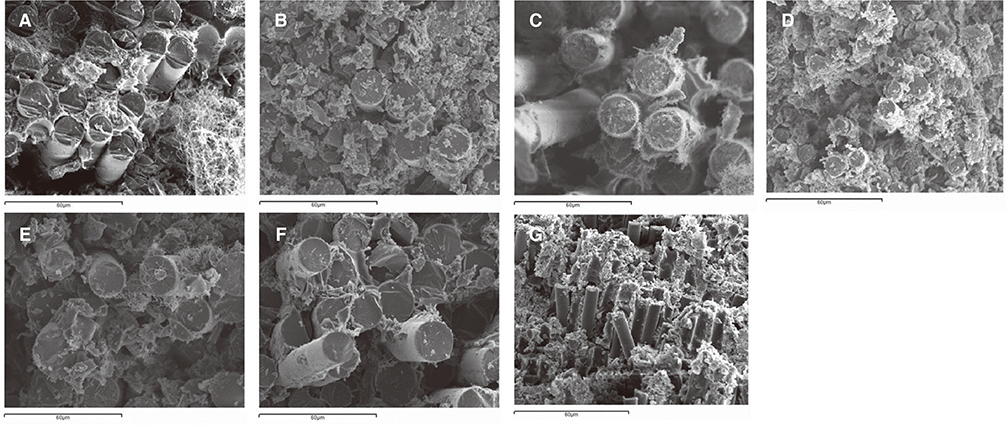J Adv Prosthodont.
2016 Dec;8(6):433-438. 10.4047/jap.2016.8.6.433.
Mechanical properties related to the microstructure of seven different fiber reinforced composite posts
- Affiliations
-
- 1Department of Surgery and Medical and Surgical Specialties, Faculty of Medicine and Dentistry, University of Santiago de Compostela, Santiago de Compostela, A Coruña, Spain. iria.lopez.darriba@rai.usc.es
- 2Instituto de Cerámica, University of Santiago de Compostela, Santiago de Compostela, A Coruña, Spain.
- KMID: 2382588
- DOI: http://doi.org/10.4047/jap.2016.8.6.433
Abstract
- PURPOSE
The aim of this in vitro study was to evaluate the mechanical properties (bending strength and hardness) of seven different fiber reinforced composite posts, in relation to their microstructural characteristics.
MATERIALS AND METHODS
Two hundred eighty posts were divided into seven groups of 40, one group for each type of post analyzed. Within each group, 15 posts were subjected to three-point bending strength test, 15 to a microhardess meter for the Knoop hardness, and 10 to Scanning Electron Microscope in order to determine the diameter of the fibers and the percentage of fibers embedded in the matrix. To compare the flexural strength in relation to the type of fiber, matrix, and the hardness of the posts, a Kruskal-Wallis H test was used. The Jonckheere-Terpstra test was used to determine if the volume percent of fibers in the post influenced the bending strength.
RESULTS
The flexural strength and the hardness depended on the type of fibers that formed the post. The lower flexural strength of a post could be due to deficient bonding between the fiber and the resin matrix.
CONCLUSION
According to the results, other factors, besides the microstructural characteristics, may also influence the mechanical properties of the post. The feature that has more influence on the mechanical properties of the posts is the type of fiber.
MeSH Terms
Figure
Reference
-
1. Fernandes AS, Shetty S, Coutinho I. Factors determining post selection: a literature review. J Prosthet Dent. 2003; 90:556–562.2. Asmussen E, Peutzfeldt A, Heitmann T. Stiffness, elastic limit, and strength of newer types of endodontic posts. J Dent. 1999; 27:275–278.3. Schwartz RS, Robbins JW. Post placement and restoration of endodontically treated teeth: a literature review. J Endod. 2004; 30:289–301.4. Al-Wahadni AM, Hamdan S, Al-Omiri M, Hammad MM, Hatamleh MM. Fracture resistance of teeth restored with different post systems: in vitro study. Oral Surg Oral Med Oral Pathol Oral Radiol Endod. 2008; 106:e77–e83.5. Cheung W. A review of the management of endodontically treated teeth. Post, core and the final restoration. J Am Dent Assoc. 2005; 136:611–619.6. Ree M, Schwartz RS. The endo-restorative interface: current concepts. Dent Clin North Am. 2010; 54:345–374.7. Lassila LV, Tanner J, Le Bell AM, Narva K, Vallittu PK. Flexural properties of fiber reinforced root canal posts. Dent Mater. 2004; 20:29–36.8. Forberger N, Göhring TN. Influence of the type of post and core on in vitro marginal continuity, fracture resistance, and fracture mode of lithia disilicate-based all-ceramic crowns. J Prosthet Dent. 2008; 100:264–273.9. Sirimai S, Riis DN, Morgano SM. An in vitro study of the fracture resistance and the incidence ofvertical root fracture of pulpless teeth restored with six post-and-coresystems. J Prosthet Dent. 1999; 81:262–269.10. Stewardson DA, Shortall AC, Marquis PM, Lumley PJ. The flexural properties of endodontic post materials. Dent Mater. 2010; 26:730–736.11. Drummond JL, Bapna MS. Static and cyclic loading of fiber-reinforced dental resin. Dent Mater. 2003; 19:226–231.12. Galhano GA, Valandro LF, de Melo RM, Scotti R, Bottino MA. Evaluation of the flexural strength of carbon fiber-, quartz fiber-, and glass fiber-based posts. J Endod. 2005; 31:209–211.13. Seefeld F, Wenz HJ, Ludwig K, Kern M. Resistance to fracture and structural characteristics of different fiber reinforced post systems. Dent Mater. 2007; 23:265–271.14. Mannocci F, Sherriff M, Watson TF. Three-point bending test of fiber posts. J Endod. 2001; 27:758–761.15. Cheleux N, Sharrock PJ. Mechanical properties of glass fiber-reinforced endodontic posts. Acta Biomater. 2009; 5:3224–3230.16. Dietschi D, Romelli M, Goretti A. Evaluation of post and cores in the laboratory: rationale for developing a fatigue test and preliminary results. Compend Contin Educ Dent Suppl. 1996; S65–S73.17. Boksman L, Pameijer CH, Broome JC. The clinical significance of mechanical properties in retentive posts. Compend Contin Educ Dent. 2013; 34:446–455.18. Plotino G, Grande NM, Bedini R, Pameijer CH, Somma F. Flexural properties of endodontic posts and human root dentin. Dent Mater. 2007; 23:1129–1135.19. Zicari F, Coutinho E, Scotti R, Van Meerbeek B, Naert I. Mechanical properties and micro-morphology of fiber posts. Dent Mater. 2013; 29:e45–e52.20. Newman MP, Yaman P, Dennison J, Rafter M, Billy E. Fracture resistance of endodontically treated teeth restored with composite posts. J Prosthet Dent. 2003; 89:360–367.21. Dietschi D, Duc O, Krejci I, Sadan A. Biomechanical considerations for the restoration of endodontically treated teeth: a systematic review of the literature-Part 1. Composition and micro- and macrostructure alterations. Quintessence Int. 2007; 38:733–743.22. Ferrari M, Cagidiaco MC, Goracci C, Vichi A, Mason PN, Radovic I, Tay F. Long-term retrospective study of the clinical performance of fiber posts. Am J Dent. 2007; 20:287–291.23. Cagidiaco MC, Goracci C, Garcia-Godoy F, Ferrari M. Clinical studies of fiber posts: a literature review. Int J Prosthodont. 2008; 21:328–336.24. Bitter K, Kielbassa AM. Post-endodontic restorations with adhesively luted fiber-reinforced composite post systems: a review. Am J Dent. 2007; 20:353–360.25. Grandini S, Goracci C, Monticelli F, Tay FR, Ferrari M. Fatigue resistance and structural characteristics of fiber posts: three-point bending test and SEM evaluation. Dent Mater. 2005; 21:75–82.26. Abdulmajeed AA, Närhi TO, Vallittu PK, Lassila LV. The effect of high fiber fraction on some mechanical properties of unidirectional glass fiber-reinforced composite. Dent Mater. 2011; 27:313–321.27. Vallittu PK. The effect of void space and polymerization time on transverse strength of acrylic-glass fibre composite. J Oral Rehabil. 1995; 22:257–261.28. Miettinen VM, Vallittu PK, Docent DT. Water sorption and solubility of glass fiber-reinforced denture polymethyl methacrylate resin. J Prosthet Dent. 1997; 77:531–534.29. Chieruzzi M, Pagano S, Pennacchi M, Lombardo G, D'Errico P, Kenny JM. Compressive and flexural behaviour of fibre reinforced endodontic posts. J Dent. 2012; 40:968–978.30. Torbjörner A, Fransson B. A literature review on the prosthetic treatment of structurally compromised teeth. Int J Prosthodont. 2004; 17:369–376.31. Naumann M, Koelpin M, Beuer F, Meyer-Lueckel H. 10-year survival evaluation for glass-fiber-supported postendodontic restoration: a prospective observational clinical study. J Endod. 2012; 38:432–435.32. Balkenhol M, Wöstmann B, Rein C, Ferger P. Survival time of cast post and cores: a 10-year retrospective study. J Dent. 2007; 35:50–58.33. Baba NZ, Golden G, Goodacre CJ. Nonmetallic prefabricated dowels: a review of compositions, properties, laboratory, and clinical test results. J Prosthodont. 2009; 18:527–536.34. Bottino MA, Baldissara P, Valandro LF, Galhano GA, Scotti R. Effects of mechanical cycling on the bonding of zirconia and fiber posts to human root dentin. J Adhes Dent. 2007; 9:327–331.35. Kurtz JS, Perdigão J, Geraldeli S, Hodges JS, Bowles WR. Bond strengths of tooth-colored posts, effect of sealer, dentin adhesive, and root region. Am J Dent. 2003; 16:31A–36A.
- Full Text Links
- Actions
-
Cited
- CITED
-
- Close
- Share
- Similar articles
-
- Currently there are so many fiber reinforced composite posts in the market. Some products are factory silanated but some products are not. Should I use silane for surface treatment of fiber reinforced composite posts?
- Fracture resistance of upper central incisors restored with different posts and cores
- Comparative evaluation of effects of different surface treatment methods on bond strength between fiber post and composite core
- Comparison of mechanical properties of a new fiber reinforced composite and bulk filling composites
- Effect of fiber direction on the polymerization shrinkage of fiber-reinforced composites



